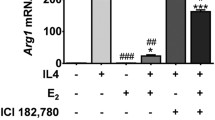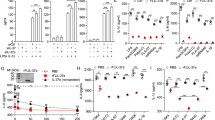Abstract
The increased incidence of autoimmune disease in premenopausal women suggests the involvement of sex steroids in the pathogenesis of these disease processes. The effects of estrogen on autoimmunity and inflammation may involve changes in the secretion of inflammatory mediators by mononuclear phagocytes. Estradiol, for example, has been reported to regulate TNF, IL-6, IL-1 and JE expression. In the present study the effects of the estrogen agonist, estriol, on cytokine expression have been investigated in mice administered a sublethal lipopolysaccharide, LPS, challenge. Pretreatment of mice with pharmacologic doses of estriol, 0.4–2 mg/kg, resulted in a significant increase in serum TNF levels in both control and autoimmune MRL/lpr mice, following LPS challenge. This increase in TNF over the placebo group was blocked by the estrogen antagonist tamoxifen. Estriol treated mice also exhibited a rapid elevation in serum IL-6 levels following LPS challenge with the peak increase occurring 1 hr post LPS. This contrasted with the placebo group in which maximal serum IL-6 levels were detected at 3 hrs post challenge. This shift in the kinetics of IL-6 increase by estriol was inhibited by tamoxifen. The estriol mediated effects on TNF and IL-6 serum levels were consistent with the changes in TNF and IL-6 mRNA observed ex vivo in elicited peritoneal macrophages. Macrophage cultures from estriol treated animals however, did not demonstrate significant differences from the placebo group for TNF or NO secretion following in vitro LPS challenge. These results suggest that the estrogen agonist estriol can have significant quantitative, TNF, and kinetic, IL-6, effects on inflammatory monokines produced in response to an endotoxin challenge.
Similar content being viewed by others
References
Walsh, R. W., I. Schiff, B. Rosner, L. Greenberg, V. Ravnikar, andF. M. Sacks. 1991. Effects of postmenopausal estrogen replacement on the concentrations and metabolism of plasma lipoproteins.New England J. Med. 325:1196.
Stampfer, M. J., G. A. Colditz, W. C. Willett, J. E. Manson, B. Rosner, F. E. Speizer, andC. H. Hennekes. 1991. Postmenopausal estrogen therapy and cardiovascular disease: ten-year follow-up from the nurse's health study.New England J. Med. 325:756.
Schaefer, E. J., D. M. Foster, L. A. Zech, F. T. Lindgren, H. B. Brewer, andR. I. Levy. 1983. The effects of estrogen administration on plasma lipoprotein metabolism in pre-menopausal females.J. Clin. Endocrinol. Metab. 57:262.
Colvin, P. L., B. J. Auerbach, L. D. Case, W. R. Hazzard, andD. Applebarum-Bowden. 1991. A dose-response relationship between sex hormone-induced change in hepatic triglyceride lipase and high density lipoprotein cholesterol in postmenopausal women.Metabolism 40:1052.
Ross, R. 1995. Cell biology of atherosclerosis.Annu. Rev. Physiol. 57:791.
Stemme, S. andG. K. Hansson. 1994. Immune mechanisms in atherogenesis.Ann. Med. 26:141.
Galis, Z. S., G. K. Sukhova, R. Kranzhofer, S. Clark, andP. Ltbby. 1994. Macrophage foam cells from experimental atheroma constitutively produce matrix-degrading proteinases.Proc. Natl. Acad. Sci. U.S.A. 92:402.
Gulshan, S., A. McCruden, andW. Stimson. 1990. Oestrogen receptors in macrophages.Scand. J. Immunol. 31:691.
Maziere, C., M. Auclair, M-F. Ronveaux, S. Salmon, S. Rantus, andJ-C. Maziere. 1991. Estrogens inhibit copper and cell-mediated modification of low density lipoprotein.Atherosclerosis 89:175.
Huber, L. A., E. Scheffler, T. Poll, R. Ziegler, andH. A. Dresel. 1990. 17 beta-estradiol inhibits LDL oxidation and cholesteryl ester formation in cultured macrophages.Free Rad. Res. Comm. 8:167.
Stock, J. L., J. A. Coderre, B. Mcdonald, andL. J. Rosenwasser. 1989. Effects of estrogen in vivo and in vitro on spontaneous interleukin-1 release by monocytes from postmenopausal women.J. Clin. Endocrinol. Metab. 68:364.
Pacifici, R., L. Rifas, R. McCracken, I. Vered, C. McMurtry, L. V. Avioli, andW. A. Peck. 1989. Ovarian steroid treatment blocks a postmenopausal increase in blood monocyte interleukin 1 release.Proc. Natl. Acad. Sci. U.S.A. 86:2398.
Hu, S. K., Y. L. Mitcho, andN. C. Rath. 1988. Effect of estradiol on interleukin 1 synthesis by macrophages.Int. J. Immunopharmacol. 10:247.
Mori, H., M. Sawairi, N. Itoh, T. Hanabayashi, andT. Tamaya. 1992. Effects of sex steroids on cell differentiation and interleukin-1 beta production in the human promyelocytic leukemia cell line HL-60.J. Reprod. Med. 37:871.
Loy, R. A., J. A. Loukides, andM. L. Polan. 1992. Ovarian steroids modulate human monocyte tumor necrosis factor alpha messenger ribonucleic acid levels in cultured human peripheral monocytes.Fertil. Steril. 58:733.
Chao, T-C., P. J. Alten, J. A. Greager, andR. J. Walte. 1995. Steroid sex hormones regulate the release of tumor necrosis factor by macrophages.Cell Immunol. 160:43.
Tabibzadeh, S. S., U. Santhanam, P. B. Sehgal, andL. T. May. 1989. Cytokine induced production of IFN-β 2/IL-6 by freshly explanted human endometrial stromal cells. Modulation by estradiol-17β.J. Immunol. 142:3134.
Girasole, G., R. L. Jilka, G. Passeri, G. Boswell, G. Boder, D. C. Williams, andS. C. Manolagas. 1992. 17 beta-estradiol inhibits interleukin-6 production by bone marrow-derived stromal cells and osteoblasts in vitro: a potential mechanism for the antiosteoporotic effect of estrogens.J. Clin. Invest. 89:883.
Frazier-Jessen, M. R., andE. J. Kovacs. 1995. Estrogen modulation of JE/monocyte chemoattractant protein-1 mRNA expression in murine macrophages.J. Immunol. 154:1838.
Shanker, G., M. Sorci-Thomas, andM. R. Adams. 1995. Estrogen modulates the inducible expression of platelet-derived growth factor mRNA by monocyte/macrophages.Life Sci. 56:499.
Holmdahl, R. 1989. Estrogen exaggerates Lupus but suppresses T-cell dependent autoimmune disease.J. Autoimmun. 2:651.
Vandenbroucke, J. P., H. A. Valkenburg, J. W. Boersma, A. Cats, J. J. M. Festen, O. Huber-Bruning, andJ. J. Raske. 1982. Oral contraceptives and rheumatoid arthritis: further evidence for a preventive effect. Lancet ii: 839.
Holmdahl, R., L. Jansson, B. Meyerson, andL. Klareskog. 1987. Oestrogen induced suppression of collagen induced arthritis: I. Long term oestradiol treatment of DBA/1 mice reduces the severity and incidence of arthritis and decrease the anti-type II collagen immune response.Clin. Exp. Immunol. 70:372.
Van Vollenhoven, R. F., andJ. L. McGuire. 1994. Estrogen, progesterone, and testosterone: Can they be used to treat autoimmune diseases? ClevelandClin. J. Med. 61:276.
Roubinian, J. R., N. Talal, J. S. Greenspan, J. R. Goodman, andP. K. Siiteri. 1978. Effect of castration and sex hormone treatment on survival, anti nucleic acid antibodies, and glomerulonephritis in NZB/NZW F1 mice.J. Exp. Med. 147:1568.
Carlsten, H., N. Nilsson, R. Jonsson, K. Backman, R. Holmdahl, andA. Tarkowski. 1992. Estrogen accelerates immune complex glomerulonephritis but ameliorates T cell mediated vasculitis and sialadenitis in autoimmune MRL lpr/lpr mice.Cell Immunol. 144:190.
Clark, J. H., W. T.Schrader, and B. W.O'Malley. 1992. Mechanisms of action of steroid hormones.In: Williams Textbook of Endocrinology. (eds. J. D. Wilson and D. W. Foster), W. B. Saunders Co. 8th edition, p. 72.
Sasson, S. 1991. Equilibrium binding analysis of estrogen agonists and antagonists: Relation to the activation of the estrogen receptor.Path. Biol. 39:59.
Sheehan, K. C. F., N. H. Ruddle, andR. D. Schreiber. 1989. Generation and characterization of hamster monoclonal antibodies that neutralize murine tumor necrosis factors.J. Immunol. 142:3884.
Zuckerman, S. H., N. Bryan-Poole, G. F. Evans, L. Short, andA. L. Glasebrook. 1995. In vivo modulation of murine serum TNF and IL-6 levels during endotoxemia by estrogen agonists and antagonists.Immunol. 86:18.
Stuehr, D. J., andC. F. Nathan. 1989. Nitric oxide. A macrophage product responsible for cytostasis and respiratory inhibition in tumor target cells.J. Exp. Med. 169:1543.
Friedman, D., F. Netti, andA. D. Schreiber. 1985. Effects of estradiol and steroids on the clearance of Immunoglobulin G coated erythrocytes.J. Clin. Invest. 75:162.
Fujimoto, J., M. Hori, T. Itoh, S. Ichigo, M. Nishigaki, andT. Tamaya. 1995. Danazol decreases transcription of estrogen receptor gene in human monocytes.Gen. Pharm. 26:507.
Cutolo, M., S. Accardo, B. Villaggio, P. Clerico, M. Bagnasco, D. A. Coviello, G. Carruba, M. Casto, andL. Castagnetta. 1993. Presence of estrogen-binding sites on macrophage-like synoviocytes and CD8+, CD29+, CD45RO+T lymphocytes in normal and rheumatoid synovium.Arthrit. Rheum. 36:1087.
Ray, A., K. E. Prefontaine, andP. Ray. 1994. Down modulation of interleukin-6 gene expression by 17β-estradiol in the absence of high affinity DNA binding by the estrogen receptor.J. Biol. Chem. 269:12940.
Zuckerman, S. H., andN. Bryan-Poole. 1995. Estrogen induced alterations in lipoprotein metabolism in autoimmune MRL/lpr mice.Arterioscler. Thromb. Vasc. Biol. 15:1556.
Terebuh, P. D., I. G. Otterness, R. M. Strieter, P. M. Lincoln, J. M. Danforth, S. L. Kunkel, andS. W. Chensue. 1992. Biologic and immunohistochemical analysis of interleukin-6 expression in vivo.Amer. J. Pathol. 140:649.
Evans, G. F., andS. H. Zuckerman. 1991. Glucocorticoid-dependent and independent mechanisms involved in lipopolysaccharide tolerance.Eur. J. Immunol. 21:1973.
Akira, S., T. Taga, andT. Kishimoto. 1993. Interleukin-6 in biology and medicine.Adv. Immunol. 54:1.
Fattori, E., M. Cappelletti, P. Costa, C. Sellitto, L. Cantoni, M. Carelli, R. Faffioni, G. Fantuzzi, P. Ghezzi, andV. Poli. 1994. Defective inflammatory response in Interleukin 6-deficient mice.J. Exp. Med. 180:1243.
Author information
Authors and Affiliations
Rights and permissions
About this article
Cite this article
Zuckerman, S.H., Ahmari, S.E., Bryan-Poole, N. et al. Estriol: A potent regulator of TNF and IL-6 expression in a murine model of endotoxemia. Inflammation 20, 581–597 (1996). https://doi.org/10.1007/BF01488797
Issue Date:
DOI: https://doi.org/10.1007/BF01488797




